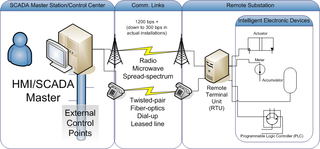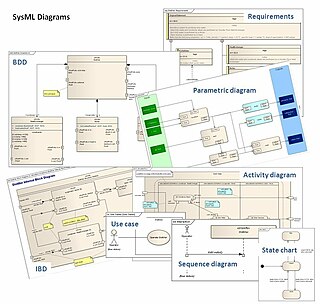External links
- OMG Website CSIv2
- Specification (OMG website)
| This computer networking article is a stub. You can help Wikipedia by expanding it. |
In distributed computing, CSIv2 (Common Secure Interoperability Protocol Version 2) is a protocol implementing security features for inter-ORB communication. It intends, in part, to address limitations of SSLIOP.
Distributed computing is a field of computer science that studies distributed systems. A distributed system is a system whose components are located on different networked computers, which communicate and coordinate their actions by passing messages to one another. The components interact with one another in order to achieve a common goal. Three significant characteristics of distributed systems are: concurrency of components, lack of a global clock, and independent failure of components. Examples of distributed systems vary from SOA-based systems to massively multiplayer online games to peer-to-peer applications.
In distributed computing, an object request broker (ORB) is a middleware which allows program calls to be made from one computer to another via a computer network, providing location transparency through remote procedure calls. ORBs promote interoperability of distributed object systems, enabling such systems to be built by piecing together objects from different vendors, while different parts communicate with each other via the ORB.
In distributed computing, SSLIOP is an Internet Inter-ORB Protocol (IIOP) over Secure Sockets Layer (SSL), providing confidentiality and authentication.
| This computer networking article is a stub. You can help Wikipedia by expanding it. |

The Object Management Group (OMG) is a computer industry standards consortium. OMG Task Forces develop enterprise integration standards for a range of technologies.
The Open Systems Interconnection model is a conceptual model that characterizes and standardizes the communication functions of a telecommunication or computing system without regard to its underlying internal structure and technology. Its goal is the interoperability of diverse communication systems with standard protocols. The model partitions a communication system into abstraction layers. The original version of the model defined seven layers.
Distributed Component Object Model (DCOM) is a proprietary Microsoft technology for communication between software components on networked computers. DCOM, which originally was called "Network OLE", extends Microsoft's COM, and provides the communication substrate under Microsoft's COM+ application server infrastructure.
An interface description language or interface definition language (IDL), is a specification language used to describe a software component's application programming interface (API). IDLs describe an interface in a language-independent way, enabling communication between software components that do not share one language. For example, between those written in C++ and those written in Java.
Message-oriented middleware (MOM) is software or hardware infrastructure supporting sending and receiving messages between distributed systems. MOM allows application modules to be distributed over heterogeneous platforms and reduces the complexity of developing applications that span multiple operating systems and network protocols. The middleware creates a distributed communications layer that insulates the application developer from the details of the various operating systems and network interfaces. APIs that extend across diverse platforms and networks are typically provided by MOM.
A security protocol is an abstract or concrete protocol that performs a security-related function and applies cryptographic methods, often as sequences of cryptographic primitives. A protocol describes how the algorithms should be used. A sufficiently detailed protocol includes details about data structures and representations, at which point it can be used to implement multiple, interoperable versions of a program.
The Open Mobile Alliance (OMA) is a standards body which develops open standards for the mobile phone industry. It is not a formal government-sponsored standards organization like the ITU, but a forum for industry stakeholders to agree on common specifications for products and services.
The Secure Communications Interoperability Protocol (SCIP) is a multinational standard for secure voice and data communication, for circuit-switched one-to-one connections, not packet-switched networks. SCIP derived from the US Government Future Narrowband Digital Terminal (FNBDT) project after the US offered to share details of FNBDT with other nations in 2003. SCIP supports a number of different modes, including national and multinational modes which employ different cryptography. Many nations and industries develop SCIP devices to support the multinational and national modes of SCIP.
The Data Distribution Service (DDS) for real-time systems is an Object Management Group (OMG) machine-to-machine standard that aims to enable dependable, high-performance, interoperable, real-time, scalable data exchanges using a publish–subscribe pattern.

DNP3 is a set of communications protocols used between components in process automation systems. Its main use is in utilities such as electric and water companies. Usage in other industries is not common. It was developed for communications between various types of data acquisition and control equipment. It plays a crucial role in SCADA systems, where it is used by SCADA Master Stations, Remote Terminal Units (RTUs), and Intelligent Electronic Devices (IEDs). It is primarily used for communications between a master station and RTUs or IEDs. ICCP, the Inter-Control Center Communications Protocol, is used for inter-master station communications. Competing standards include the older Modbus protocol and the newer IEC 61850 protocol.
Conch is an implementation of the secure shell (SSH) protocol written in the Python programming language. SSH is a protocol designed to allow remote access to shells and commands. Conch can be used to implement both the client and server sides of this protocol.

The Systems Modeling Language (SysML) is a general-purpose modeling language for systems engineering applications. It supports the specification, analysis, design, verification and validation of a broad range of systems and systems-of-systems.
The Advanced Message Queuing Protocol (AMQP) is an open standard application layer protocol for message-oriented middleware. The defining features of AMQP are message orientation, queuing, routing, reliability and security.
Web Services Interoperability Technology (WSIT) is an open-source project started by Sun Microsystems to develop the next-generation of Web service technologies. It provides interoperability between Java Web Services and Microsoft's Windows Communication Foundation (WCF).
According to the DHS S&T website, the Command, Control, and Interoperability Division was a unit of the DHS Science and Technology Directorate which "develops interoperable communication standards and protocols for emergency responders, cyber security tools for protecting the integrity of the Internet, and automated capabilities to recognize and analyze potential threats."
A distributed social network or federated social network is an Internet social networking service that is decentralized and distributed across distinct providers. It consists of multiple social websites, where users of each site communicate with users of any of the involved sites. From a societal perspective, one may compare this concept to that of social media being a public utility.
OTP is a collection of useful middleware, libraries, and tools written in the Erlang programming language. It is an integral part of the open-source distribution of Erlang. The name OTP was originally an acronym for Open Telecom Platform, which was a branding attempt before Ericsson released Erlang/OTP as open source. However neither Erlang nor OTP is specific to telecom applications.

Modelio is an open-source UML tool developed by Modeliosoft, based in Paris, France. It supports the UML2 and BPMN standards.
SMPTE ST 2071 is a suite of standards published by the Society of Motion Picture and Television Engineers (SMPTE) that define a framework, protocol, and method of service discovery for the control of objects within an Internet of Things. The standards focus on the interoperability and discoverability of objects within the network, and treat media as first-class citizen. The standard also describes a programming methodology that allows objects to describe their behaviors (features) to other objects over the network and allows objects to change their behavior dynamically at runtime. Application developers developing to the SMPTE ST 2071 standards focus on writing their applications to the behaviors they wish to support and not the object or class of object that implements those behaviors.